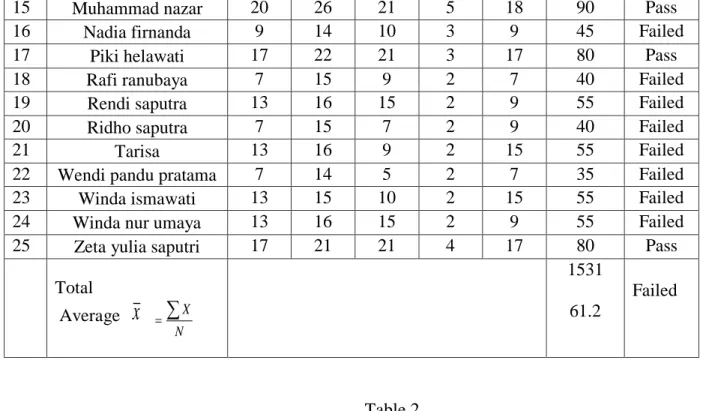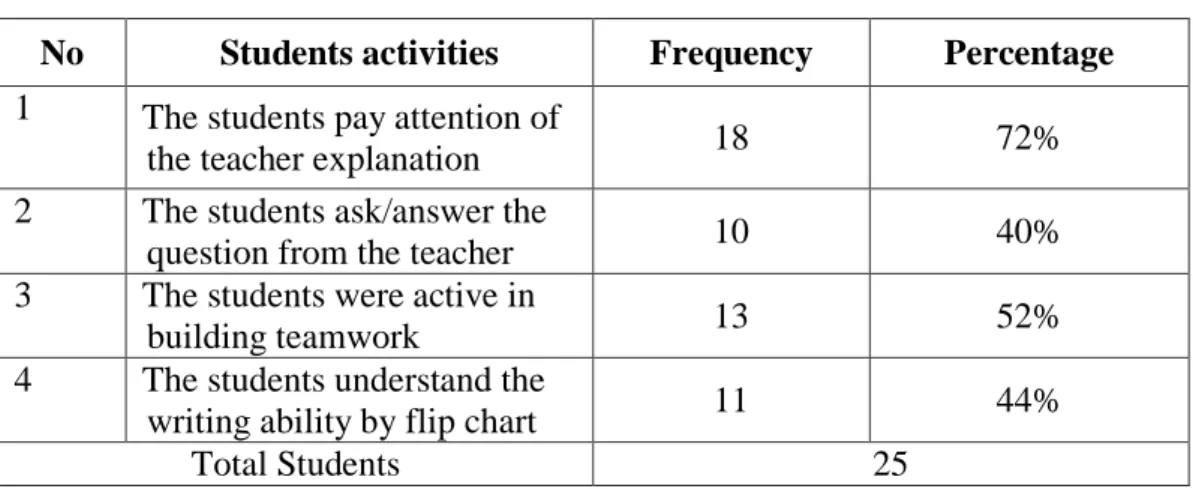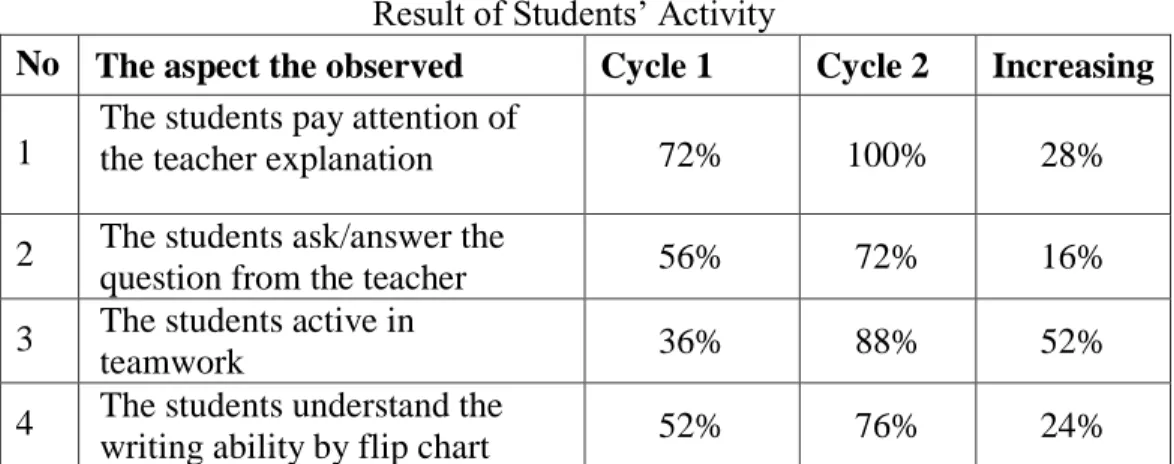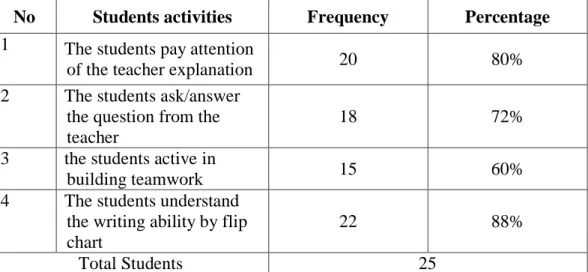Tujuan dari penelitian ini adalah untuk mengetahui bagaimana penggunaan FLIP CHART dapat meningkatkan keterampilan menulis deskriptif siswa kelas VIII SMP Purnama Trimurjo. Berdasarkan penelitian yang dilakukan, penulis menemukan bahwa media flip chart dapat meningkatkan kemampuan menulis siswa kelas VIII SMP Purnama Trimurjo.
MOTTOS
INTRODUCTION
- Problem Identification
- Problem Limitation
- Problem Formulation
- Objective of the Study
- Benefits Of The Studies
- Prior research
This blackboard medium is one medium that can be used to improve students' writing skills. 2Mazroatun Kamilah, The effect of using the table on students' ability to write descriptive text (Experimental study for second grade students of SMP N 3 Ketangungan Brebes in Tegal academic year: Pancasakti Tegal University, 2011) p.5.

THEORETICAL REVIEW
The concept of writing ability 1. Definition of writing ability
- Types of Writing
- The Abilities Of Writing Descriptive Text
- Levels Of Writing Ability At The Eighth Grade Of The Smp Purnama Trimurjo
- The Problem Of Developing Writing Ability
- The principles of flip chart
- Procedure of Flip Chart in teaching writing ability
- The Steps Of Using Flip Chart In Teaching Writing Ability
- The advantages and disadvantages of flip chart
For this, there are some components involved in the act of writing, namely (1) mastery of the written language that will be used as a writing medium, including vocabulary, sentence structure, paragraphing, spelling, pragmatics, etc. (2) mastery of the content of the essay according to the topic , which we will write, and (3) mastery of writing types, that is, how to compose the content of the writing using the language of writing the desired article, e.g. as essays, short stories and papers. .. 7Linderman, Erika, Elementary Writing with a Practical Approach, Little Brown Company, New York, 1984, p.11. Then we must first determine the subject, choose a subject that we ever see, hear, or feel. therefore writing will not be difficult because we already see or feel. the second examines the topic, that is, if we already know the object that will be used as descriptive text, for example, what shape, how much size, and so on. there are many other questions more specific to writing that can be more lively. the third is to write, if he studied the above things and then continue to write, writing in famous English is difficult, sometimes the writing model is bener, the grammar is wrong yes, the same writing is considered wrong, also vice versa.
Action Hypothesis
According to Hendricks, Action Research is a powerful tool for studying and improving one's practice.24 Furthermore, McNiff says Action Research is a specific way to research one's own learning. It is a practical way to look at your practice to check if it is as you feel it should be.25 This means that action research is an activity to practice and analyze the students. This research will be conducted in SMP Purnama Trimurjo located in Trimurjo, Central Lampung in the Academic Year of 2017/2018.
The researcher who conducted this research, the eighth grade students of SMP Purnama Trimurjo in the Academic Year of 2017/2018.
The Subject of The Research
The researcher asked the English teacher as a collaborator in this research to function as a controller in the teaching learning process. So, it is easy for the researcher to know the development of the students who were active students in the teaching learning process.
Procedure of The Research
So the researcher has easy to know the development of the students who were the students' active in the teaching in the learning process. managers, administrators or even parents – consider worth investigating more deeply and systematically. From the quote above, it can be inferred that classroom action research is a research on teaching and learning in the classroom which aims to solve a problem or to repair something. Classroom action research is also conducted collaboratively to search for solutions to everyday problems found in the classroom or to find a way to improve students' performance in their studies, especially in English classroom.
In this research, the researcher needs a collaborator to help her in this research, it is prompted to share the problem that occurs in the learning process. After completing the planning, the learning process would be done in eighth classes by SMP Purnama Trimurjo. Observation carried out to collect information about the learning process carried out by researchers in accordance with the actions that have been prepared.
By collecting information, the researcher can see the weaknesses and strengths of the researchers in the implementation of the action, so that the results can be used as input when the researcher conducts reflection to prepare plans in the next cycle. In this step, the researcher observed the teaching learning process using an observation sheet.
Data Collection Technique
Based on the cycle 1 evaluation of the weakness that was felt, then the second cycle of action is developed and so on. The pre-test was given in the first meeting before doing treatments to know the students' abilities before doing the action research. This treatment had done in the last meeting after making treatments has something as purpose to find out the change of students.
The improvement may lie in determining whether the post-test average score is higher than the pre-test. The researcher used observation to obtain data on student and teacher activity in the learning process. The purpose of this observation is the use of flipchart media by a teacher and students activity.
Using this method, the researcher obtained information about the history of the school, the total number of teachers, official employees and students at SMP purnama trimurjo and a picture of learning activities in the classroom. To collect data more accurately, the writer will use a field note to facilitate data analysis.
Data Analysis Technique
Then, she selected the data related to the research question and classified them into the categories of attraction given in the learning process. Data analysis would be performed step by step the mean score of pretest and posttest.
Indicator of Success
- The History of SMP Purnama Trimurjo
- The mission of the school
- The Condition of the Teacher and Official Staff of SMP Purnama Trimurjo
- The Quantity of the Students at SMP Purnama Trimurjo The students‟ quantity of SMP Purnama Trimurjo is 106 that can
- The Organization Structure of SMP Purnama Trimurjo The Organization Structure of SMP Purnama Trimurjo in the
- The Location of SMP Purnama Trimurjo
- Cycle I
- Cycle II
This means that the students did not achieve the minimum score at SMP Purnama Trimurjo and the students' writing ability was low. Therefore, this was the reason why the researcher used FLIP CHART as a media to improve the students' writing ability. The researcher conducted pre-test to know the students' writing ability in descriptive text before treatment was given and this was used as the comparison score with post-test.
The students had to create a descriptive text based on the topic in 40 minutes. Here, the researcher was as a teacher and the English teacher as an assistant observing the activities of the students during the learning process. However, the score of most of the students had improved, although the condition of the learning process was uncontrolled enough.
Based on the result above, the researcher indicated that the learning process in cycle II was successful because the students' activity percentage got 70%. Based on the results of the students, activities in cycle I and cycle II were improved.

INTERPRETATION 1. Cycle I
- Cycle II
- The Result of Students’ Learning Activities in Cycle I and Cycle II The students‟ learning activities data was gotten from the whole
This means that in cycle I the students' performance could improve enough, but it was not successful because the indicator of successful has not yet been reached. After analyzing the students' score in the post-test of cycle I, the researcher had to carry out the next cycle because only 9 students (36%) passed the test and got the score 70. From the results of the students' score from post-test II, it could be concluded that there was an increase score.
Based on the results of the pre-test, post-test I and post-test II, it appeared that there was an improvement in the students' scores. The result of the students' learning activities in cycle I and cycle II Data for the students' learning activities were obtained from the whole Data for the students' learning activities were obtained from the entire students' learning activities on observation sheets. The students' attention to the teacher's explanation increased from the first meeting to the next meeting.
Students who understood the teacher's material improved from the first session to the next. Based on the above data, it can be concluded that students felt comfortable and active in the learning process, as most students showed good progress in learning activities when teachers used table media to train students' writing skills in I and cycle. II.

DISCUSSION
In this chapter, the researcher wants to suggest the teachers in teaching writing and the technique that can be used in teaching writing.
Conclusion
Suggestion
Douglas Brown, Teaching by Principle, London: Longman, 1998 Janet Allen, Multiple Tools for Teaching Content Skills, American, 2008. Pike, csp,cpae, Creative Training Techniques Handbook: Tips, Tactics and How-To's for Delivering Effective Training, Canada : 2002. Rowena Murray and Sarah Moore, The handbook of academic writing a fres approach, New york: mc graw hill, open university press, 2006.
Basic Competences
Indicators
The Purpose of Learning
The Material
- Definition of Descriptive Text
- Language Feature
- Example of descriptive Text
Teaching Technique - Written test
Teaching Learning Activities
- POST-TEACHING
The teacher asks the students to write down the ideas they got from the discussion. The teacher asks the students to create descriptive text that relates to the idea they are dealing with.
Media in Learning Activities 1. White board
Evaluation
Less input and output; problems with body ideas; no evidence is supported. Handles the given topic easily; ideas are concrete and highly developed; no irrelevant material;.
Standard Competence
- Basic Competences
Indicators
The Purpose of Learning
The Material
- Definition of Descriptive Text
- Language Feature
- Example of descriptive Text Identification
Teaching Technique - Written test
Teaching Learning Activities
- Media in Learning Activities 4. White board
Evaluation
- AJI RIYANTO
- ALIF FARDIANSYAH
- AMRAL GIYAN PRADIPA
- DE ASTINI
- FAJAR OKTA ROMADHON
- HANIF MAULADI ISMAN
- INTAN KHASANAH
- MARINDA SETIA ARSITA
- MUHAMAD EKA SAPUTRA
- NADIA FIRNANDA
- RAFI RANUBAYA
- RIDHO SAPUTRA
- RIDHO SAPUTRA 21 TARISA
Development of ideas that are not complete or ideas are somewhat off topic; sections are not divided quite correctly. 26-22 Good Average to good; some knowledge of the subject, mostly relevant to the subject but lacking in detail. 17-14 Good Average to good; loosely organized, limited support and logical but incomplete sequencing, relevant to generic structure but sometimes with unclear sentences.
13-10 Fair Poor to fair; not fluid, ideas confused, no logical sequence, generic structure not clear. 13-10 Fair Poor or fair: limited range, frequent errors in words/idioms, form, choice, usage, meaning confused or unclear. 9-7 Bad Very bad; essentially translation, little knowledge of vocabulary, idiom, word out, or not enough to evaluate.
10-5 Poor Very poor: virtually no mastery of sentence construction rules, dominated by errors, did not communicate, or not enough to evaluate. 3 Fair Poor to fair; frequent spelling errors, punctuation, capitalization, paragraphing, poor handwriting, confused meaning, or blurred. 2 Poor Very poor; no mastery of conventions, dominated by spelling, punctuation, capitalization, paragraphs, handwriting, illegible or not enough to evaluate.
CURRICULUM VITAE
